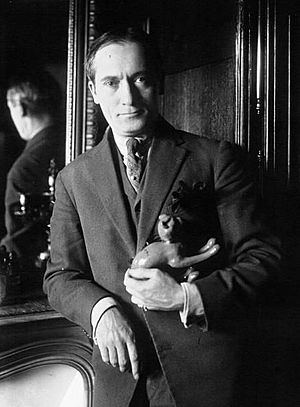Maurice Dekobra facts for kids
Maurice Dekobra (born May 26, 1885, in Paris – died June 1, 1973, in Paris) was a famous French writer. His real name was Ernest-Maurice Tessier.
He was seen as a very modern writer in the 1920s and 1930s. He became one of the most well-known French writers between the two World Wars. His books were translated into 77 languages! This made him one of the first international bestselling authors. His most famous book was La Madone des Sleepings (published in 1925).
Even though he was very popular, some people in 2005 thought he was "totally unknown." However, his book La Madone des Sleepings was re-released in 2006. This helped more people in France learn about him again.
About His Life
Maurice Dekobra started his career at age 19 as a journalist. He could write in three languages: French, English, and German.
During World War I (1914–1918), he worked as a special officer. He helped armies from India and the United States talk to each other. Meeting people from different countries made him love to travel.
He said his pen name, Dekobra, came from a trip to North Africa. He saw a snake charmer with two cobras. He thought of "deux cobras" (two cobras in French), which sounded like "De-kobra," and then "Dekobra."
People even made up a word, 'dekobrisme,' to describe his writing style. It meant he mixed news-like facts into his novels.
Maurice Dekobra lived in the United States from 1939 to 1946. When he returned to France, he started writing detective stories, also known as whodunits. One of his detective novels, Opération Magali (1951), won a special award called the Prix du Quai des Orfèvres.
His Books on Screen
Many of Maurice Dekobra's novels were turned into movies.
- Prince or Clown (1928), based on his novel Prince ou Pitre.
- Madonna of the Sleeping Cars (1928), based on his most famous novel La Madone des sleepings.
- Latin Quarter (1929), based on his novel Quartier Latin.
- Friends and Lovers (1931), based on Le Sphinx a parlé.
- The Phantom Gondola (1936), based on La Gondole aux chimères.
- Yoshiwara (1937), based on his novel Yoshiwara.
- Hell Is Sold Out (1951), based on Satan refuse du monde.
- Madonna of the Sleeping Cars (1955), another film based on La Madone des sleepings.
He Also Wrote Screenplays and Directed
Maurice Dekobra also wrote movie scripts for other films, like La Sirène des tropiques (1927). He even directed one film himself, called La rafle est pour ce soir (1954).
See also
 In Spanish: Maurice Dekobra para niños
In Spanish: Maurice Dekobra para niños


